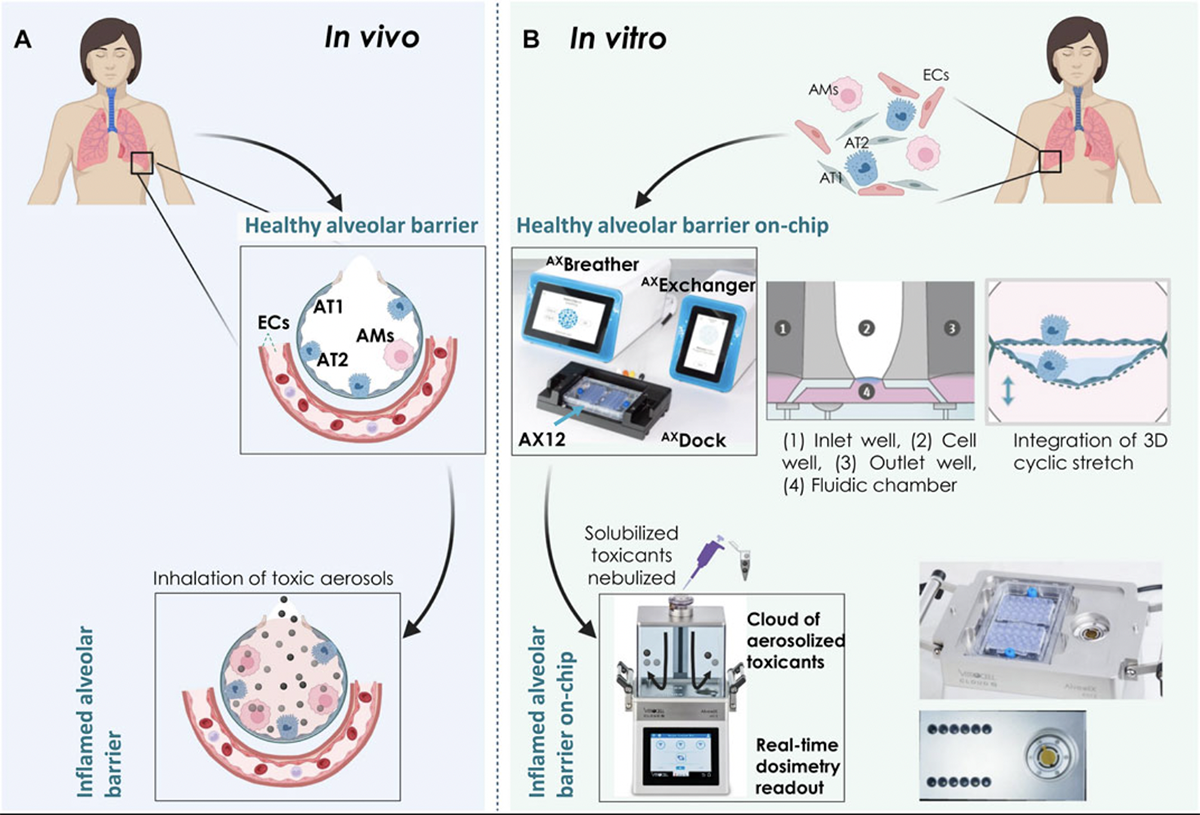2023/03/15 | Research | In-vitro & Organs-on-Chip
New in vitro lung inhalation model for toxicity assessment and treatment
Prolonged exposure to respirable toxicants can lead to severe respiratory diseases such as asthma, chronic obstructive pulmonary disease, and fibrosis. In-vitro human-relevant lung inhalation models can help to better predict the effect of airborne toxicants in preclinical research, as well as prove useful for development of new inhaled drugs. The ARTORG Organs-on-Chip Technologies lab has developed a new inhalation model for the distal lung, capable of mimicing the fragile and dynamic alveolar microenvironment in collaboration with AlveloliX AG, Vitrocell Systems and the Inselspital. This state-of-the-art human-relevant pre-clinical tool could significantly reduce use of animals for toxicity risk assessment and drug safety studies.
 Overview of the Cloud α AX12 platform
A) An illustration showing the alveolar barrier in situ. Inhaled toxic particles are represented as black and grey spheres. Inhalation of such airborne toxic particles result in lung inflammation, toxicity, and progression to COPD.
(B) Schematic representation of the AXLung-on-chip and Cloud α AX12 platform to model healthy and inflamed alveolar barrier in vitro. Primary and immortalized cells isolated from human sources were used in the model. Inflammation on-chip was mimicked using nebulized toxic compounds and nanoparticles with the Cloud α AX12.
(https://doi.org/10.3389/fphar.2023.1114739)
Overview of the Cloud α AX12 platform
A) An illustration showing the alveolar barrier in situ. Inhaled toxic particles are represented as black and grey spheres. Inhalation of such airborne toxic particles result in lung inflammation, toxicity, and progression to COPD.
(B) Schematic representation of the AXLung-on-chip and Cloud α AX12 platform to model healthy and inflamed alveolar barrier in vitro. Primary and immortalized cells isolated from human sources were used in the model. Inflammation on-chip was mimicked using nebulized toxic compounds and nanoparticles with the Cloud α AX12.
(https://doi.org/10.3389/fphar.2023.1114739)
In a recent paper the team described their mechanistic approach using a new generation of exposure systems, the Cloud α AX12. This in-vitro inhalation tool consists of a cloud-based exposure chamber (VITROCELL) that seamlessly integrates the breathing AXLung-on-chip technology (AlveoliX). The AXLung-on-chip enabled air-liquid interface culture conditions along with three-dimensional cyclic stretch. Complex multi-cellular models were established to model the distal alveolar barrier and the upper airways.
To mimic in-vivo relevant aerosol exposures with this new inhalation platform, three different proof-of-concept models were established using: a) nanoparticles b) toxic chemical and c) anti-inflammatory inhaled corticosteroid. Validation of these toxicity results were obtained using primary and immortalized human alveolar epithelial cells co-cultured with macrophages and endothelial cells.
Results suggest an important synergistic effect on the air-blood barrier sensitivity, cytotoxicity, and inflammation, when air-liquid interface and cyclic stretch culture conditions are combined, thus closely mimicking the in-vivo conditions within the human lung.